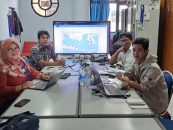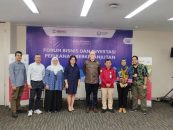Data describing the status of the blue swimming crab (Portunus pelagicus) fishery was collected from three important sites including Jakarta, Rembang, and Pamekasan-.‐Madura in Java Sea (WPP 712) in 2016 by the Center for Fisheries Research and Development Ministry of Marine Affairs and Fisheries, and Indonesian Blue Swimming Crab Association over a period of 7 months between May and November 2016. Field data was collected at each sampling station by scientiest and enumerators.
Three thousand and ninety-.‐fives (3,095) females and two thousand,two hundred and sixteen (2,216) males Blue Swimming Crab (BSC) were measured by enumerators at three sampling locations in Java Sea in 2016. The smallest and the largest female crabs caught were measured 64.94 mm and 163.70 mm carapace width (CW), respectively. The average size of female crabs caught in the Jakarta measured 126.58 mm (Standard Deviation 12.17 mm), 125.61 mm (Standard Deviation 12.75 mm) in Rembang, and 115.49 mm (Standard Deviation 15.47 mm) in Pamekasan-.‐Madura.
Length‐Based Spawning Potential Ratio (LB SPR) is a new and delightfully unconventional approach to stock assessment, developed over the past six years by a team of scientists in Western Australia led by Jeremy Prince and Adrian Hordyck. The LB SPR approach enables fishing communities and fishery managers in less developed countries (and elsewhere) to assess the status of fish stocks and then make local decisions about future management measures. Spawning potential ratio (SPR) – also referred to spawning potential per recruit –is not a new concept in the annals of fishery science. The estimated spawning potential ratio (SPR) for the BSC fishery in Java Sea was 0.21 (StdDev 0.005) in Rembang and 0.28 (StdDev 0.007) in Pamekasan-.‐ Madura. The residual spawning potential (SP) of the BSC stock in Java Sea after fishing in 2016 was therefore 21% in Rembang and 28% in Madura. The results of the LB SPR assessment indicate that the BSC fishery in Java Sea was operating at above limit reference point (i.e, the Limit References Point SP = 20%) in 2016.
The lenght on selectivity (SL) for 50% and 95% of the catch were 123.3 mm (1.51 mm) in Rembang and 118.6 mm (2.19 mm) in Madura, respectively. The selectivity curve for the BSC fishery in all sampling sites was positioned well to the right of generic maturity curve of the population of Portunus pelagicus from the BSC fishery in Indonesia. The results of the LB SPR assessment suggest that the operation of the fishery enables almost all BSC to mature before entering the fishery.
Please find attached the Stock Assessment Report 2016 in this LINK .




No Comments so far
Jump into a conversationNo Comments Yet!
You can be the one to start a conversation.